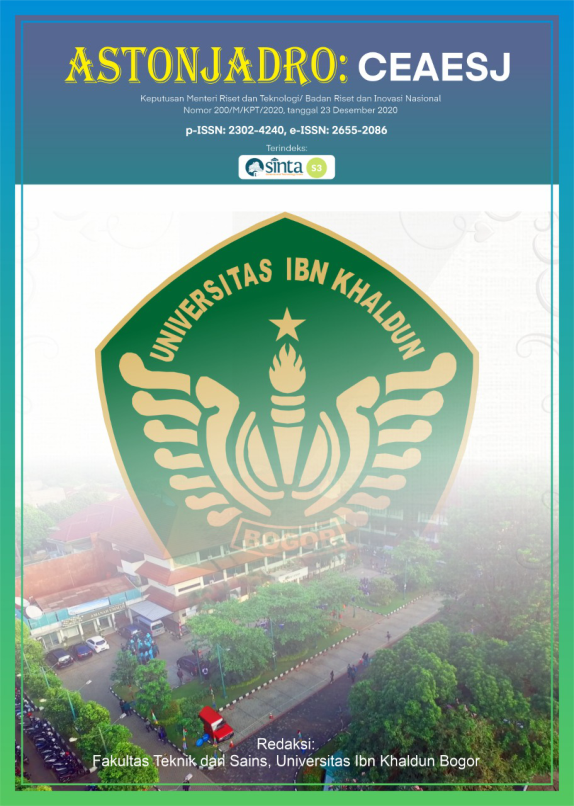RESISTANCE OF MORTAR WITH PPC CEMENT AND GEOPOLYMER MORTAR WITH WHITE SOIL SUBSTITUTION IN H2SO4 IMMERSION
DOI:
https://doi.org/10.32832/astonjadro.v10i2.4579Keywords:
geopolymer mortar, white soil, corrosive, resistance.Abstract
This study analyzes the effect of immersion of H2SO4 (sulfuric acid) solution with a concentration of 10% on porosity, density and compressive strength of mortar with PPC cement and geopolymer with white soil substitution mortar. The purpose of this study was to determine the resistance of mortar with PPC cement and geopolymer with white soil substitution mortar when immersed in 10% H2SO4 solution. The test object was 5x5x5 cm mortar with materials used including fly ash from PLTU Tanjung Jati B Jepara, white soil from Kupang, fine aggregate, water and alkaline activator in the form of a mixture of 8M NaOH and Na2SiO3 and also PPC cement. The composition of the geopolymer mortar mixture is 1binder: 3Fine Aggregate: 0,5Water-Binder Ratio, while the mortar with PPC cement is made with a composition of 1PPC: 3Fine Aggregate: 0,5Water-Cement Ratio. The geopolymer mortar was made in 6 variations with a white soil substitution percentage of 0-25% with an increase of 5% for each variation. Compressive strength testing using a compression test apparatus. The test results show that the variation in the percentage of white soil substitution has less effect on the size of the porosity value. As for the value of compressive strength and density, white soil substitution has an effect, the higher the white soil substitution, the higher the compressive strength and mortar density values. Geopolymer mortar was better to withstand 10% sulfuric acid solution, while mortar with PPC cement had no resistance to 10% sulfuric acid solution because it continued to deteriorate over the course of the day. The greatest compressive strength is in variation IV (15% white soil substitution) of 15,31 MPa at 28 days of age, while the smallest porosity and greatest density are in variation VI (25% white soil substitution) of 0,17% and 2,205 grams/cm3.
References
Bhutta, M. A. R., Farhayu Ariffin, N., Hussin, M. W., & Shukor Lim, N. H. A. 2013. Sulfate and Sulfuric Acid Resistance of Geopolymer Mortars Using Waste Blended Ash. Jurnal Teknologi (Sciences and Engineering), 61(3), 1–5. https://doi.org/10.11113/jt.v61.1762
Hunggurami, E., Simatupang, P., & Lori, A. (2015). Studi Kelayakan Penggunaan Tanah Putih Sebagai Pengganti Agregat Halus (Pasir) Terhadap Kualitas Beton. Jurnal Teknik Sipil Nusa Cendana, 4(1), 29–38. https://doi.org/10.13140/rg.2.2.29125.09440. (Indonesian).
Joseph Davidovits. 1994. Properties of Geopolymer Cements. First International Conference on Alkaline Cements and Concretes, 131–149.
Lloyd, N. A., & Rangan, B. V. 2010. Geopolymer Concrete with Fly Ash. 2nd International Conference on Sustainable Construction Materials and Technologies, 7, 1493–1504.
Mehta, P. K. 2004. High-Performance, High-Volume Fly Ash Concrete for Sustainable Development. International Workshop on Sustainable Development and Concrete Technology, 3–14.
Mulyana, F., Yolanda, T., Nurhuda, I., & Nuroji. (2017). Studi Beton Geopolimer Sebagai Subtitusi Beton Konvensional. Konferensi Nasional Teknik Sipil 11, 137–146. (Indonesian).
Pandu Dimas Gumilang, Hendramawat Aski Safarisky, Marwahyudi Marwahyudi, 2021. PRESS STRONG CONCRETE ADDED SHELL OF KEONG SAWAH, Jurnal Rekayasa Sipil 10 (1), pp 81-85. http://ejournal.uika-bogor.ac.id/index.php/ASTONJADRO/article/view/3986
Priastiwi, Y. A., Hidayat, A., Daryanto, D., Salamsyah, Z., Teknik, F., & Diponegoro, U. 2020. Pengaruh Substitusi Tanah Putih pada Mortar Geopolimer Berbahan Dasar Fly Ash dengan Aktifator Natrium Hidroksida. Media Komunikasi Teknik Sipil, 26(1), 9–16. (Indonesian).
Priastiwi, Y. A., Adi, R. Y., Prabawa, R. A., Leksono L.B. 2020. Pengaruh Substitusi Tanah Putih Dari Kupang Nusa Tenggara Timur Terhadap Porositas Pada Mortar Geopolimer Dengan Aktivator Senyawa Sodium Silikat. Jurnal TEKNIK. (Indonesian).
Parhimpunan Purba. 2006. Pengaruh Kandungan Sulfat Terhadap Kuat Tekan Beton. Jurnal Teknik Sipil PSD III, UNDIP, 4(1), 37–42. https://doi.org/10.14710/metana.v4i1.1723. (Indonesian).
Salain, I. M. A. K. 2007. Perbandingan Kuat Tekan dan Permeabilitas Beton yang Menggunakan Semen Portland Pozzolan dengan yang Menggunakan Semen Portland Tipe I. Seminar Dan Pameran HAKI 2007 - "Konstruksi Tahan Gempa Di Indonesia,” 1–6. (Indonesian).
Sultan, M. A., Imran, & Litiloly, F. 2018. Korelasi Porositas Beton Terhadap Kuat Tekan Rata-Rata. Teknologi Sipil, 2(2), 57–63. (Indonesian).
Syaiful S. 2020. Analysis on the Addition of Fiber the Strong Bending Mixed Concrete, ARPN Journal of Engineering and Applied Science. 15(6): 724-729. http://www.arpnjournals.org/jeas/research_papers/rp_2020/jeas_0320_8152.pdf
Syaiful S. 2021. Additional Betonmix To Increase The Strength Of Concrete Press. ARPN Journal of Engineering and Applied Science. 16(15): 1583-1589. http://www.arpnjournals.org/jeas/research_papers/rp_2021/jeas_0821_8652.pdf
Wulandari, C., Wibisono, M., & Sitompul, I. R. 2015. Durabilitas Mortar Geopolimer Di Air Gambut. Jom FTEKNIK, 2(2), 1–15. (Indonesian).
Downloads
Published
How to Cite
Issue
Section
License
Paper submitted to ASTONJADRO is the sole property of the Astonjadro Journal. Unless the author withdraws the paper because he does not want to be published in this journal. The publication rights are in the journal Astonjadro.ASTONJADRO
LICENSE
This work is licensed under a Creative Commons Attribution-ShareAlike 4.0 International License.
Based on a work at http://ejournal.uika-bogor.ac.id/index.php/ASTONJADRO













